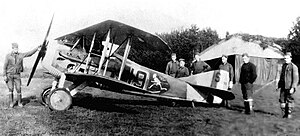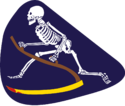| 13th Aero Squadron | |
|---|---|
 13th Aero Squadron – SPAD XIII assigned to Major Charles Biddle, likely taken at Souilly Airdrome, France, 1918 | |
| Active | 14 June 1917 – 29 March 1919 |
| Country | |
| Branch | |
| Type | Squadron |
| Role | Pursuit |
| Part of | American Expeditionary Forces (AEF) |
| Fuselage Code | "Grim Reapers" [1] |
| Engagements | World War I |
| Commanders | |
| Notable commanders | Captain (later Major) Charles J. Biddle[1] Lt. Dickinson Este[2] |
| Insignia | |
| 13th Aero Squadron Emblem "Grim Oscar" |  |
| Aircraft flown | |
| Fighter | SPAD XIII, 1918[3][4] |
| Trainer | Curtiss JN-4, 1917[3][4] |
| Service record | |
|---|---|
| Operations |
2d Pursuit Group
|
| Victories |
Air Aces: 7
|
The 13th Aero Squadron was a United States Army Air Service unit that fought on the Western Front during World War I.
The squadron was assigned as a Day Pursuit (Fighter) Squadron as part of the 2d Pursuit Group, First United States Army. Its mission was to engage and clear enemy aircraft from the skies and provide escort to reconnaissance and bombardment squadrons over enemy territory. It also attacked enemy observation balloons, and perform close air support and tactical bombing attacks of enemy forces along the front lines.[7] After the 1918 Armistice with Germany, the squadron returned to the United States in March 1919 and demobilized.[4][8]
On 16 October 1936 the squadron was re-constituted, and consolidated with the United States Army Air Corps 13th Attack Squadron. Today, the current United States Air Force unit which holds its lineage and history is the 13th Bomb Squadron, assigned to the 509th Operations Group, Whiteman Air Force Base, Missouri.[9]
- ^ a b c Over the Front: A Complete Record of the Fighter Aces and Units of the United States and French Air Services, 1914–1918 Norman Franks, Frank W. Bailey. Grub Street, 1992. ISBN 0-948817-54-2, ISBN 978-0-948817-54-0.
- ^ AFHRA 13th Bomb Squadron History Archived 13 October 2014 at the Wayback Machine
- ^ a b Cite error: The named reference
Mauerwas invoked but never defined (see the help page). - ^ a b c d Series "E", Volume 9, History of the 11th–13th Aero Squadrons. Gorrell's History of the American Expeditionary Forces Air Service, 1917–1919, National Archives, Washington, D.C.
- ^ Series "H", Section "O", Volume 29, Weekly Statistical Reports of Air Service Activities, October 1918 – May 1919. Gorrell's History of the American Expeditionary Forces Air Service, 1917–1919, National Archives, Washington, D.C.
- ^ a b c Gorrell's History of the American Expeditionary Forces Air Service, Series M, Volume 38, Compilation of Confirmed Victories and Losses of the AEF Air Service as of 26 May 1919
- ^ "Maurer, Maurer (1978), The US Air Service in World War I, The Office of Air Force History, Headquarters USAF Washington" (PDF). Archived from the original (PDF) on 27 September 2013. Retrieved 1 September 2013.
- ^ Order of Battle of the United States Land Forces in the First World War, Volume 3, Part 3, Center of Military History, United States Army, 1949 (1988 Reprint)
- ^ Rogers, Brian. United States Air Force Unit Designations Since 1978. Hinkley, England: Midland Publications, 2005. ISBN 1-85780-197-0.